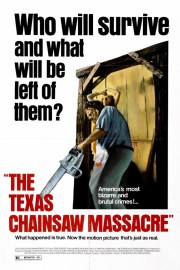The Texas Chain Saw Massacre
There’s a simple reason that Tobe Hooper’s original “Texas Chain Saw Massacre” retains its hold as one of the great cinematic nightmares, and any modern reboot or remake will never touch it. It was clear to me the second I watched it for the first time in 2003 in the lead up to the Michael Bay-produced remake- Hooper’s film is ugly. This is full-on exploitation cinema, and it feels like I shouldn’t be watching it. Hooper started his career as a documentary cinematographer, and that documentary feel is built in to the way he shoots this film. We shouldn’t be thrilled but horrified in watching this story, and every minute of the film’s 83 feels skeevy and dirty. Would this style have worked for “Halloween” or “Friday the 13th?” Maybe for the latter, but because they feel more plotted than Hooper’s film, a sense of them as movies is important to being able to be enjoyed. This film is another matter entirely.
The screenplay by Hooper and Kim Henkel starts off with a crawl setting the scene, which is read by John Larroquette. A small Texas town has been rocked by graverobbers who have desecrated a nearby cemetery. A brother and sister (Paul A. Partain and Marylin Burns) and three friends take a trip to make sure a loved one’s grave isn’t one of the ones affected. On the way back, they pick up a hitchhiker (Edwin Neal), and though they had good intentions, they should have left well enough alone, as he’s a bit twisted, and leaves them scarred. That isn’t their biggest mistake, however, as that happens when they go to check out this old house. When they start to look around, it’s covered in bones and skeletons, and they soon discover, they are not alone.
Hooper’s film, and especially, the character of Leatherface, takes a lot of inspiration from the story of Ed Gein, and it’s fascinating that Gein’s life was a central inspiration for two horror classics- the other one is Hitchcock’s “Psycho.” Both films are ground zero for the era of the slasher movie that would take hold after “Halloween” and “Friday the 13th” and their endless imitations, and especially “Massacre” sets the template to follow: isolate a handful of teens or young adults, set loose a killer, and craft a thriller around that. It’s not hard to see how it caught on, but what’s interesting is how bloodless, literally, Hooper’s film feels in comparison. For a film with the title it does, “Texas Chain Saw Massacre” is more about implied gore than the gallons of blood that would later be influenced by it. Where its blunt-force trauma impact comes from, instead, is the fast and loose manner of Hooper’s direction, the cinematography by Daniel Pearl, the editing by J. Larry Carroll and Sallye Richardson, and a sound mix that amplifies the instruments of terror used by Leatherface, as well as the cackles of his family, which plays a truly unsettling part in this story. This is one of the scariest films to listen to in movie history, and I don’t say that lightly- some horror films get their kicks from silence before sudden terror. You watch “Texas Chain Saw Massacre” hoping for a calm before the coming storm.
The final piece of the puzzle is Leatherface himself, and Gunnar Hansen delivers an unforgettable villain. He is the butcher in this family of cannibals, and he’s almost not human. Rather than normal human sounds, he makes animal-like grunts that give him a more disturbing character. The choice to make him mentally retarded is a smart one, because when the rest of his family shows up for a meal with Burns’s Sally as a “guest,” we get a cavalcade of broken humanity thrown our way, and it leads to probably the most unnerving material in the film. This is a movie that ends powerfully and potently. Other slasher films would have been good to take notes. Some did, but some didn’t take the right hints from what Hooper did to make their films among the best in the history of the genre. Then again, that just shows how original Hooper’s film was.










